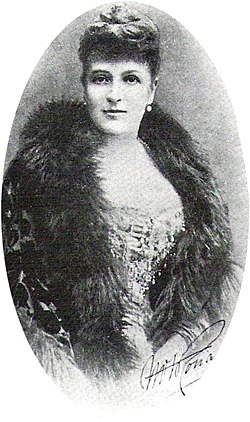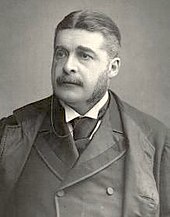Fanny Ronalds

Mary Frances Ronalds RRC DStJ (née Carter; August 23, 1839 – July 28, 1916) was an American socialite and amateur singer who is best known for her long affair with the composer Arthur Sullivan in London in the last decades of the nineteenth century and for her musical salons.
After separating from her husband, Ronalds moved with her children from New York to Paris in 1867, then to Tunis in 1869, and eventually to London in 1875. She was accepted into royal social circles and was a popular hostess. A noted beauty, she became romantically involved with Arthur Sullivan during the 1870s and continued as his companion until his death in 1900. She was much admired as a singer and became famously associated with one of Sullivan's most popular songs, "The Lost Chord".
Early life
Ronalds, generally called "Fanny", was born in Boston, Massachusetts, the daughter of Joseph Ballard Carter (1813–1889) and his wife,[1][2] Mary (née Chamberlain) Carter (died 1898).[3][4] In 1859 at age twenty, already known as a beauty with a talent for singing, she married Pierre Lorillard Ronalds (grandson of Pierre Lorillard II), a New Yorker called by The New York Times, "The Father of American Coaching".[5] The young Mrs. Ronalds quickly became a noted socialite and hostess. At one magnificent ball that she gave in the early 1860s, Ronalds famously appeared dressed "as Music, in a white satin gown embroidered with bars from Verdi's Un ballo in maschera", wearing a harp-shaped, illuminated crown.[6] The Ronalds had four children.[7] A contemporary account described Ronalds as follows: "Her face was perfectly divine in its loveliness, her features small and exquisitely regular. Her hair was a dark shade of brown – châtain foncé [deep chestnut] – and very abundant... a lovely woman, with the most generous smile one could possibly imagine, and the most beautiful teeth."[6]
By 1867, she had separated from her husband, whom she never divorced. She developed a relationship with the wealthy Leonard Jerome (Winston Churchill's grandfather), a notorious womanizer, but somehow maintained a friendship with his wife and daughters, including Jennie Churchill, who remembered Ronalds singing them to sleep.[6] She often visited their home in Newport, Rhode Island, and when Mrs. Jerome moved to Paris with her daughters, Ronalds followed, taking her younger children.[1] There, noted for her beauty and social talents, she joined the court circles of the pleasure-loving Empress Eugénie and Napoleon III.[5][8] During a party, Napoleon rescued her after she fell into one of his ponds.[9] She soon met Arthur Sullivan during one of his visits to Paris. According to The New York Times, she became the leader of the American community in Paris.[5] In 1868, in the French courts, Ronalds obtained a legal separation from her husband, giving her control over their children.[7]
Introduced by Napoleon and Eugénie to British society, she quickly became one of the many "friends" of the Prince of Wales (later King Edward VII) and was soon known for hosting fashionable musical entertainments and elegant soirées for artists, musicians and high society.[1][5][10] With the faltering of the Second Empire as unrest grew in France, her opportunities there collapsed, and Ronalds moved with her children to Tunis in 1869. There she became a partner in a farm near Sidi Thabet with Ferdinand Veillet-Devaux, the Count de Sancy; after some legal troubles, the venture ended in 1875.[11]
Years as Sullivan's mistress

In early 1875, Ronalds left Tunis and moved to London.[1][11] She had continued to maintain her friendship with Jennie Jerome, who became Lady Randolph Churchill in 1874.[8][12] She later became friendly with Queen Victoria and Queen Alexandra.[5][13]
Ronalds' affair with Sullivan began not long after she moved to London. Three years his senior, she was in her mid-thirties and beautiful, with a strong personality.[14] Social conventions of the time compelled them to keep their relationship discreet. She was still married, but even had she been divorced, Sullivan would not have been willing to face the social stigma of marrying a divorcee.[15] Their relationship deepened after the deaths of his brother Fred (1877) and his mother (1882).[14] Sullivan became close with Ronalds' children and parents, especially after his brother Fred's family moved to America in 1883. In his diaries, Sullivan referred to her as "Mrs. Ronalds" when he saw her in a public setting, but "L. W." (for "Little Woman") when they were alone together, often with a number in parentheses indicating the number of sexual acts completed.[16][17] It is thought that Ronalds was pregnant on at least two occasions,[18] and she apparently procured an abortion in 1882 and again in 1884.[19] The 1999 biographical film Topsy-Turvy depicts Sullivan and Ronalds discussing an abortion at around the time of the production of The Mikado. Eleanor David portrays Ronalds in the film.[20]
Sullivan had a roving eye, and his diary records the occasional quarrel when one of his many other liaisons was discovered, but he always returned to Ronalds.[14][21] She was his constant companion until his death in 1900, but by about 1889 or 1890, the sexual relationship seems to have ended.[22] He started to refer to her in the diary as "Auntie" (she also was called "auntie" by his nephew, Herbert Sullivan), and the tick marks indicating sexual activity were no longer there, although similar notation continued to be used for his relationships with other women who have not been identified and who were always referred to by their initials.[23]
Ronalds was an excellent and much admired singer, using her voice for good causes since her days in New York, when she gave concerts in aid of Civil War troops; later "in Paris she was known as the "Patti des Salons".[24] Sullivan described her as "the best amateur singer in London".[25] She often performed Sullivan's songs at her famous Sunday soirees.[1][14] She became particularly associated with one of his most popular songs, "The Lost Chord", which he composed in 1877 as he watched over his dying brother. Ronalds became its most famous interpreter, singing it both in private and in public, often with Sullivan himself accompanying her.[26][27] When Sullivan died, he left her the autograph manuscript of that song, along with other bequests.[28] For Ronalds, Sullivan composed the song "St. Agnes' Eve".[29] Ronalds also wrote songs, including "In Shadow" (1881).[30]

In 1899 when the Boer War broke out, Ronalds was elected treasurer of an American ladies' effort to finance a hospital ship, the RFA Maine, to be sent to South Africa.[31][32] She was also active in charitable work for the Red Cross and received the Royal Red Cross among other honours.[33] In July 1901 she was appointed an Honorary Lady of Grace of the Order of St. John.[34]
Death and legacy
When Ronalds died in 1916, at the age of 76, a copy of the manuscript of "The Lost Chord" was buried with her, at her request.[35][36] She is buried in the Brompton Cemetery in London.[37] In an inscription to a wreath that she sent to the funeral, Princess Louise described Ronalds as "one of the kindest and most unselfish of women".[13] She was survived by her children, Pierre Lorillard Ronalds, Jr., Reginald Ronalds (who became a Rough Rider)[38] and Fannette ("Fannie") Ritchie.[5][13]
Notes
- ^ a b c d e Ainger, p. 129
- ^ Jacobs, p. 459
- ^ MacLeod, p. 72
- ^ "Mrs. Joseph Ballard Carter Dead", The New York Times, 14 March 1898, accessed 6 September 2018
- ^ a b c d e f "Mrs. Ronalds Dies in Her London Home", The New York Times, July 31, 1916, p. 5
- ^ a b c Jacobs, p. 85
- ^ a b "French Divorce", New York Herald, 29 April 1868, p. 9
- ^ a b Jacobs, p. 86
- ^ "Mrs. Pierre L. Ronalds Dead", The New York Times, June 4, 1910, p. 9
- ^ Malcolm, Sir Ian. Fifty Years When Youth Was Gilded, War and the Larger Freedom The Times, Mar 23, 1932, p. 15
- ^ a b Schuman, Frederick L. War and Diplomacy in the French Republic, McGraw-Hill (1931), Chapter IV, "The Taking of Tunis", pp. 60–61
- ^ Kelly, C. Brian and Ingrid Smyer. Best Little Stories from the Life and Times of Winston Churchill, p. 374, Cumberland House, (2008) ISBN 1-58182-634-6
- ^ a b c The Times, August 3, 1916, p. 9
- ^ a b c d Barker, John W. "Gilbert and Sullivan" Archived 2008-07-23 at the Wayback Machine, Madison Savoyards.org (2005), accessed 12 April 2009
- ^ Jacobs, p. 87
- ^ Jacobs, pp. 156–57, 161, 171, etc.
- ^ Ainger, p. 177
- ^ Jacobs, pp. 178 and 203-04
- ^ Ainger, pp. 210 and 237-38
- ^ Shepherd, Marc. "Topsy-Turvy (1999)", A Gilbert and Sullivan Discography, accessed 20 November 2009
- ^ Ainger, p. 198
- ^ Ainger, pp. 306 and 342
- ^ Jacobs, pp. 289 and 295
- ^ Martin, Frederick Townsend. Things I Remember, pp. 49–51 and 183, London: Eveleigh Nash (1913)
- ^ Ainger, p. 167. In the 1860s and 1870s, it was more respectable for "society" ladies to remain amateur (Jacobs, p. 86).
- ^ Ainger, p. 135
- ^ Grossmith, George. "Sir Arthur Sullivan: A Personal Reminiscence". The Pall Mall magazine, Volume 23, p. 252, George Routledge & Sons, Ltd., 1901
- ^ Ainger, p. 390
- ^ St. Agnes’ Eve”[permanent dead link] at The Gilbert and Sullivan Archive, June 29, 2004
- ^ The Graphic, July 2, 1881, p. 24
- ^ Ainger, p. 378
- ^ S.S. Maine Medallions, Willem Joubert Collection, March 10, 2006
- ^ "Funeral of Mrs. Ronalds", The New York Times, August 3, 1916, p. 9
- ^ "No. 27330". The London Gazette. 5 July 1901. p. 4469.
- ^ Ainger, p. 128.
- ^ D'Oyly Carte conductor David Mackie notes in his book Arthur Sullivan and The Royal Society of Musicians (The Royal Society of Musicians of Great Britain, 2006, p.143 ISBN 0-9509481-3-6) that Mrs. Ronalds is buried with a copy and bequeathed the original manuscript to Dame Clara Butt, who had recorded the song several times (see Buckley, Jack. "In Search of The Lost Chord". MusicWeb International, accessed 2 September 2010). Butt's husband was the baritone Kennerley Rumford. In 1950, Rumford gave the manuscript Worshipful Company of Musicians, which still owns it.
- ^ Court Circular, The Times, August 1, 1916, p. 11
- ^ "Mrs. Ronalds Begins Suit for Separation", The New York Times, July 29, 1910, p. 4
References
- Ainger, Michael (2002). Gilbert and Sullivan – A Dual Biography. Oxford: Oxford University Press. ISBN 0-19-514769-3.
- Jacobs, Arthur (1986). Arthur Sullivan – A Victorian Musician. Oxford University Press. ISBN 0-19-282033-8.
- MacLeod, Charlotte (2016). Christmas Stalkings: Tales of Yuletide Murder. Open Road Media. ISBN 9781504042550.
